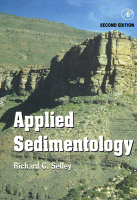Browse content
Table of contents
Actions for selected chapters
- Full text access
- Book chapterAbstract only
1 - Introduction
Pages 1-18 - Book chapterNo access
Index
Pages 513-521 - Book chapterNo access
About the Author
Page 523
About the book
Description
There are three types of rock—igneous, metamorphic and sedimentary. Sedimentary rocks form from the weathering, erosion, transportation and deposition of older rocks. Applied Sedimentology describes the formation, transportation and deposition of sediment, and the post-depositional processes that change soft sediment into sedimentary rock. Sedimentary rocks include sandstones, limestones and mudstones. All the world's coal, most of its water and fossil fuels, and many mineral deposits occur in sedimentary rocks. Applied Sedimentology shows how the study of sediments aids the exploration for and exploitation of natural resources, including water, ores and hydrocarbons.
There are three types of rock—igneous, metamorphic and sedimentary. Sedimentary rocks form from the weathering, erosion, transportation and deposition of older rocks. Applied Sedimentology describes the formation, transportation and deposition of sediment, and the post-depositional processes that change soft sediment into sedimentary rock. Sedimentary rocks include sandstones, limestones and mudstones. All the world's coal, most of its water and fossil fuels, and many mineral deposits occur in sedimentary rocks. Applied Sedimentology shows how the study of sediments aids the exploration for and exploitation of natural resources, including water, ores and hydrocarbons.
Key Features
* Completely revised edition; Like its precursor, it describes sediments from sand grains to sedimentary basins; Features up-to date account and critique of sequence and cyclostratigraphy
* Extensively illustrated with photos and remotely sensed sea bed images describing sedimentary processes, products and depositional systems; Color plates illustrate sediment textures, lithologies, pore types, diagenetic textures, and carbonate and clastic sequence stratigraphic models
* Emphasises the applications of sedimentology to the exploration for and exploitation of natural resources, including water, ores and hydrocarbons
* Extensive references and up-to-date bibliography for further study
* Completely revised edition; Like its precursor, it describes sediments from sand grains to sedimentary basins; Features up-to date account and critique of sequence and cyclostratigraphy
* Extensively illustrated with photos and remotely sensed sea bed images describing sedimentary processes, products and depositional systems; Color plates illustrate sediment textures, lithologies, pore types, diagenetic textures, and carbonate and clastic sequence stratigraphic models
* Emphasises the applications of sedimentology to the exploration for and exploitation of natural resources, including water, ores and hydrocarbons
* Extensive references and up-to-date bibliography for further study
Details
ISBN
978-0-12-636375-3
Language
English
Published
2000
Copyright
Copyright © 2000 Elsevier Inc. All rights reserved
Imprint
Academic Press
